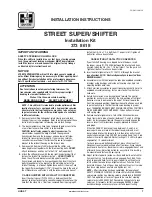
1. Verify that the battery is fully charged.
z
Recharge it if necessary. (See
BATTERY INSPECTION [MZI-3.7]
.)
2. Warm up the engine to the normal operating temperature.
3. Perform "Fuel Line Safety Procedure". Leave the fuel pump relay removed. (See
BEFORE SERVICE
PRECAUTION [MZI-3.7]
.)
4. Remove the engine cover. (See
ENGINE COVER REMOVAL/INSTALLATION [MZI-3.7]
.)
5. Remove the dynamic chamber and throttle body as a single unit. (See
INTAKE-AIR SYSTEM
REMOVAL/INSTALLATION [MZI-3.7]
.)
6. Remove the ignition coils. (See
IGNITION COIL REMOVAL/INSTALLATION [MZI-3.7]
.)
7. Remove the spark plugs.
8. Measure the compression pressure using the following procedure.
1. Connect the compression gauge into the spark plug hole.
2. Crank the engine
a minimum of five
compression strokes and record the highest reading.
Fig. 38: Measuring Compression Pressure
Courtesy of MAZDA MOTORS CORP.
3. Repeat the test on each cylinder, cranking the engine approximately the same number of
compression strokes.
4. The indicated compression pressures are considered within specification if the lowest reading
cylinder is within
75%
of the highest reading. Refer to the
COMPRESSION PRESSURE LIMIT
CHART
.
z
Fuel vapor is hazardous. It can very easily ignite, causing serious
injury and damage. Always keep sparks and flames away from fuel.
z
Fuel line spills and leakage are dangerous. Fuel can ignite and cause
serious injures or death and damage. Fuel can also irritate skin and
eyes. To prevent this, always complete the "Fuel Line Safety
Procedure". (See BEFORE SERVICE PRECAUTION [MZI-3.7] .)
NOTE:
z
Note the approximate number of compression strokes required
to obtain the highest reading.
2008 Mazda CX-9 Grand Touring
2008 ENGINE Mechanical (MZI-3.7) - Mazda CX-9
Microsoft
Sunday, November 15, 2009 10:01:57 AM
Page 28
© 2005 Mitchell Repair Information Company, LLC.
















































